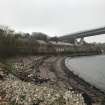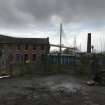Ordnance Survey licence number AC0000807262. All rights reserved. © Copyright and database right 2024.
Useful Links
- Canmore:
- SOUTH QUEENSFERRY, PORT EDGAR HARBOUR, BARRACKS
- Historic Scotland:
- HS Reference No 50988
General Details and Location
Category
AT RISK
Name of Building
Port Edgar Barracks/ Naval Hospital
Other Name(s)
Address
South Queensferry
Locality
Postcode
Planning Authority
Divisional Area
Reference No
4005
Listing Category
B
OS Grid Ref
NT 1165 7870
Location Type
Small Town
HS Reference No
50988
Description
Group of 1- and 2-storey red brick gabled barrack buildings with regular fenestration, arranged on narrow site either side of central access road. Concrete window cills and lintels. Predominantly small-pane glazing in timber sash and case windows (most windows boarded up 2006). Welsh slate roofs with terracotta ridge tiles. Cast-iron rainwater goods. Some decorative cast-iron street-lamp brackets attached to buildings.
Built in 1918 as the barrack accommodation for Port Edgar, which has considerable historical interest for its former use as a Royal Naval base for the servicing of Torpedo Boat Destroyers in the 1st World War and as a Minesweeping base in the 2nd World War. These buildings as a group stand as a rare and intact example of a naval barracks. Port Edgar was acquired by the Royal Navy in 1916, and was commissioned as HMS Columbine in 1917 for use as a Destroyer Base for the Grand Fleet. Unlike most ships, Destroyers were not self-supporting and required special servicing facilities that were provided at Port Edgar. This set of buildings were used as barracks until 1927, when the Navy temporarily moved out of the site. During the 1930s the barracks were used as holiday camp accommodation for poor families. Prior to the 2nd World War, it was decided to move the existing military hospital at Butlaw (situated a few hundred yards to the N) into the barracks. The 1938 operating theatre was built at this time. During the 2nd World War Port Edgar was commissioned as HMS Lochinvar and became the main minesweeping base in Scotland. It continued in use as the Royal Navy's training base for minesweeping until it closed in 1975. (Historic Environment Scotland List Entry)
Built in 1918 as the barrack accommodation for Port Edgar, which has considerable historical interest for its former use as a Royal Naval base for the servicing of Torpedo Boat Destroyers in the 1st World War and as a Minesweeping base in the 2nd World War. These buildings as a group stand as a rare and intact example of a naval barracks. Port Edgar was acquired by the Royal Navy in 1916, and was commissioned as HMS Columbine in 1917 for use as a Destroyer Base for the Grand Fleet. Unlike most ships, Destroyers were not self-supporting and required special servicing facilities that were provided at Port Edgar. This set of buildings were used as barracks until 1927, when the Navy temporarily moved out of the site. During the 1930s the barracks were used as holiday camp accommodation for poor families. Prior to the 2nd World War, it was decided to move the existing military hospital at Butlaw (situated a few hundred yards to the N) into the barracks. The 1938 operating theatre was built at this time. During the 2nd World War Port Edgar was commissioned as HMS Lochinvar and became the main minesweeping base in Scotland. It continued in use as the Royal Navy's training base for minesweeping until it closed in 1975. (Historic Environment Scotland List Entry)
Building Dates
Circa 1918
Architects
Category of Risk and Development History
Condition
Poor
Category of Risk
Moderate
Exemptions to State of Risk
Field Visits
6/10/2010, 07/05/2021
Development History
May 2009: Former barracks/ hospital site may not be in use. For Investigation.
June 2010: External inspection finds the buildings currently in use as National Museums of Scotland store. Set to ALERT to monitor site as the potential new Forth road bridge is likely to cross the site.
23 February 2016: Site not thought to have been affected by the construction of the new road bridge. Moved to Not For Register.
February 2017: Nominated for the Register by a member of the public as disused. Previously utilised as stores by National Museum of Scotland, the buildings are understood to have been decanted following the construction of a purpose-built storage facility for their museum. Some of the building may have been, or are, in use by the construction staff for the new Queensferry road bridge. Note this summary entry may apply to a large number of individual buildings. Moved back to For Investigation.
October 2019: A member of the public notes that the buildings are in a dilapidated state. Walls and roofs are damaged or missing, ivy is covering walls and vegetation is well established.
7 May 2021: External inspection finds the site disused with security fencing around boundary. Close inspection of each building was not possible. From what could be viewed, there was evidence of slipped slates on roofs and possible issues with flashings. All chimney pots have been removed. Rainwater goods are missing in parts and damaged in others. The basic brick structure appears sound. Some windows have been boarded up while others have glazing and astragals missing. Doors have been boarded up. Moved to At Risk.
Post Survey Update.
The site has recently been acquired by a housing association with the intention of converting the complex to housing.
Post Survey Update.
The site has recently been acquired by a housing association with the intention of converting the complex to housing.
Guides to Development
Conservation Area
Planning Authority Contact
PAC Telephone Number
0131 529 3901
Availability
Current Availability
Not Available
Appointed Agents
Price
Occupancy
Vacant
Occupancy Type
N/A
Present/Former Uses
Name of Owners
Type of Ownership
Housing Association
Information Services
Additional Contacts/Information Source
Bibliography
Online Resources
Classification
Military Installations
Original Entry Date
16-JUL-09
Date of Last Edit
28/01/2022





